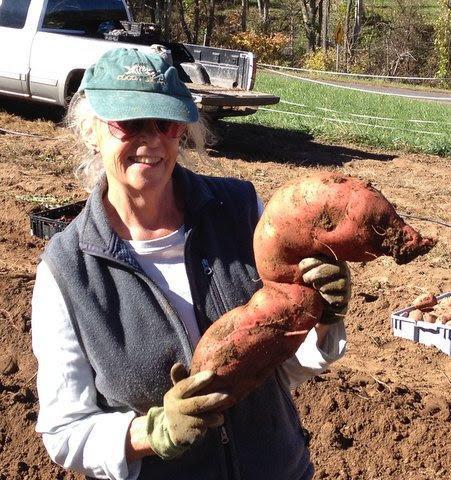Besides being delicious in almost every possible way, sweet potatoes are one of the most nutritious veggies we eat. Luckily for us gardeners, they’re also extremely easy to grow! We only need to follow a few key tips and at the end of summer we can harvest enough sweet, juicy big sweet potatoes to last all winter.
Dig Deep
In my 15 or so years of growing sweet potatoes, I’ve learned a few lessons. I’ve found that simply starting with a well prepped site can allow a very respectable harvest with very little work after planting. Raised beds are ideal for sweet potatoes, not just because they encourage loose and un-compacted soil (which sweet potatoes love), but they are easy to harvest from. You can even grow sweet potatoes in large pots or buckets! If raised beds are not possible, dig down into your planned bed at least 12” and create mounded rows or hills for each plant. This adds extra inches for tuber development. As you prep your beds, make sure to incorporate plenty of organic matter. Rotted leaves, compost, and composted manure are excellent choices.
Don’t be Too Eager to Get Started
Equally as important to loose and fertile soil is temperature. Being native to Central and South America, sweet potato plants have zero tolerance to cold temperatures, and should not be planted out until the soil has reached 60°F. This can be sped up in cooler climates by spreading out black plastic for a few weeks before your last frost date, but in zones 7 and above it’s not likely to be necessary. From planting to harvest time is 90 to 120 days depending on the variety, so if you have a shorter growing season, choose a hardier variety.
Water Well
Every year I plant my slips and am sure they aren’t going to make it, and after a week of looking like death warmed over, they wake up one morning looking like they are meant to be there. The first two weeks are crucial for establishment, so keep them well watered during this time. But don’t let them get too dry during their growth either. Sweet potatoes will be overly stressed if they get too dry, and a stressed plant will not put energy into tuber growth. Like the rest of your garden, about 1” of water a week is a good guideline.
Keep the Vines in Check
Most sweet potatoes are vining in nature, and enthusiastic ones at that. Left on their own to grow, they can quickly spread to every corner of your garden, which can be a lovely living mulch, but if you want big tubers, you’ll need to keep the vines snipped back to within 3 feet of the mother plant. In our growing climate there is only enough time for sweet potatoes to form their tubers under the parent plant, so all those extra vines are just pulling energy from the tubers and putting it into vine growth. Keeping them regularly pruned also allows for easier harvesting as it’s easier to find where you originally planted. It’s not a waste though, sweet potato greens are delicious!
The Right Fertilizer is Key
Sweet potatoes are the crop that made me a believer in having my soil tested as part of my pre-garden prepping. I got lucky the first year I planted them, and had a beautiful harvest of large, tasty tubers. The second year I was not so lucky, and while I had luscious and healthy greens, I got barely any potatoes, the ones I did pull were stunted and scrawny. The culprit? Too much nitrogen in my soil! When you have high levels of nitrogen in your soil naturally or because of things you are adding, (wood chips and chicken poop for example) you will get lots of leaf growth, but very little fruit development. Do yourself a favor and contact your county extension agency to find out how to conduct your own soil test. This will give you a good baseline on your soil health, and what you can safely add as a fertilizer without throwing things out of balance. If it is too late this season to get a soil test in time for planning and planting, when it comes to feeding your sweet potatoes err on the side of caution and use a fertilizer that is lower in nitrogen than it is in potassium and phosphorus. You should read up on this if you’re not schooled on it, but for quick reference, nitrogen is the first # in the NPK sequence. Bone meal, kelp meal, and green sand are my favorite organic choices for sweet potatoes that are lower in nitrogen than potassium and phosphorus. Don’t over-fertilize! Sweet potatoes are not heavy feeders, so these should just be an occasional snack if your soil is less than ideal.
Follow these 5 easy tips and you will soon be able to brag about the 2 pound (or more) big sweet potatoes you dug up this year!
| |
Article Written by: Angie Lavezzo |
|
About the Author: Angie Lavezzo is the former general manager of Sow True Seed. Beyond her professional role at Sow True, Angie's passion for gardening extends into personal hands-on experience, fostering plants and reaping bountiful harvests. |


